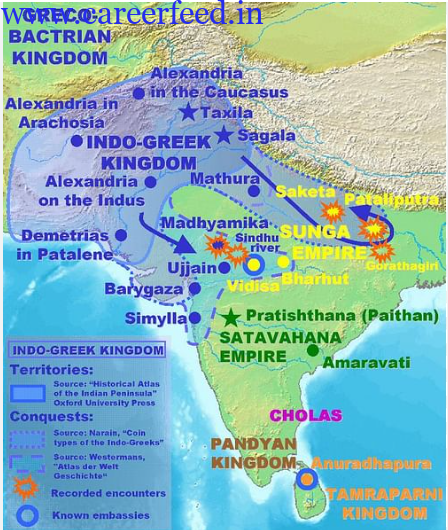Persian Invasion of India
Cyrus and Achaemenid Empire:
- Cyrus, the founder of the Achaemenid Empire in ancient Iran, invaded the North-Western front of India in 550 BCE.
- The Achaemenid Empire was one of the earliest Persian empires.
Indian Regions and Rulers:
- During that time, there were many small provinces in the North-West, including Gandhara, Kamboja, and Madra, engaged in constant conflicts.
- Bimbisara, belonging to the Haryanka dynasty, was ruling over Magadha in the eastern part of India.
Persian Control and Annexation:
- Cyrus succeeded in bringing under Persian control all the Indian tribes west of the Indus River, such as Gandhara.
- Punjab and Sindh were annexed by Darius I, the grandson of Cyrus.
Xerxes and Greek Conflict:
- Darius I’s son, Xerxes, faced challenges in further conquering India due to conflicts with the Greeks.
- Xerxes had employed Indian cavalry and infantry.
- The war with the Greeks, notably the Persian Wars, prevented further Persian conquest in India.
Timeline:
- Persian Invasion: Traced back to 550 BCE under Cyrus.
- Annexation: Punjab and Sindh annexed by Darius I.
- Obstacle: Xerxes faced challenges in further conquest due to war with the Greeks.
Effects of Persian Invasion in India
Indo-Iranian Contact:
- The Indo-Iranian contact resulting from the Persian invasion lasted for about 200 years.
- This contact had a significant impact on trade and commerce between the two regions.
Trade and Commerce:
- The invasion gave an impetus to Indo-Iranian trade and commerce.
- Iranian coins have been discovered in the northwestern frontier, indicating the existence of trade between India and Iran.
Introduction of Kharoshti Script:
- The Kharoshti script was introduced to northwest India by the Persians.
- Some of Ashoka’s inscriptions were written in the Kharoshti script in these regions.
Aramaic Influence and Script Direction:
- The Kharoshti script is derived from the Aramaic script.
- It is written from right to left, unlike many Indian scripts.
Ashoka’s Inscriptions:
- Inscriptions of Ashoka, dating back to the 3rd century BCE, were possibly inspired by the Persian king Darius.
- The rock inscriptions and monuments from Ashoka’s time show a noticeable Iranian influence.
- Elements such as the bell-shaped capitals and the preamble of Ashoka’s edicts reflect this Iranian influence.
Alexander’s Invasion (327 BCE)
Background:
- Alexander (356 BCE – 323 BCE), son of Philip of Macedonia, became king in 336 BCE.
- In the 4th century BCE, the Greeks and Iranians were in conflict for world supremacy.
Conquests and Approach to India:
- Alexander conquered Asia Minor, Iran, and Iraq.
- He marched into northwest India from Iran, attracted by India’s wealth and driven by a passion for geographical inquiry and natural history.
- Before his invasion, northwest India had small rulers like Ambhi of Taxila and Porus of the Jhelum region.
Battles and Territories:
- Alexander defeated Persian King Darius III in the Battle of Arbela (330 BC).
- Ambhi submitted to Alexander’s sovereignty, but Porus resisted, leading to the Battle of Hydaspes.
- Impressed by Porus’s fight, Alexander granted him his territory back.
- After annexing tribes between Ravi and Chenab, Alexander’s army refused to cross the river Beas, leading to his retreat in 326 BCE.
Retreat and Death:
- Alexander died at Babylon in 323 BCE, aged 32.
- His dream of an eastern empire remained unfulfilled. He erected twelve stone altars on the northern banks of Beas to mark the farthest point of his advance.
- Alexander stayed in India for 19 months.
Aftermath and Legacy:
- After Alexander’s death, the Greek Empire split in 321 BCE.
- In northwest India, Alexander left four generals in charge, including Seleucus I Nicator.
- Seleucus later traded his territories in the Indus Valley with Chandragupta Maurya.
- Eudamas served as the last General of Alexander in India.
Effects of Alexander’s Invasion
Political Unification:
- Augmented political unification in northern India under the Mauryas.
- Destruction of small states in northwest India by Alexander facilitated the Mauryan empire’s easy expansion.
Direct Contact and Trade:
- Established direct contact between India and Greece, opening up four distinct routes.
- Paved the way for Greek merchants and craftsmen to establish trade between India and Greece.
Historical Records and Chronology:
- Alexander’s historians left clearly dated records, forming the basis for Indian chronology.
- Provided information about social and economic conditions, including the sati system, the sale of girls, and flourishing carpentry.
Cultural Impact and Settlements:
- Indo-Greek rulers emerged in the northwest part of India.
- Greek settlements continued under both Chandragupta Maurya and Ashoka.
- Notable settlements included Alexandria in the Kabul region, Bonkephala on the Jhelum, and Alexandria in Sindh.
Artistic Influence:
- Grecian impact evident in Indian art, particularly seen in the Gandhara school of art.





